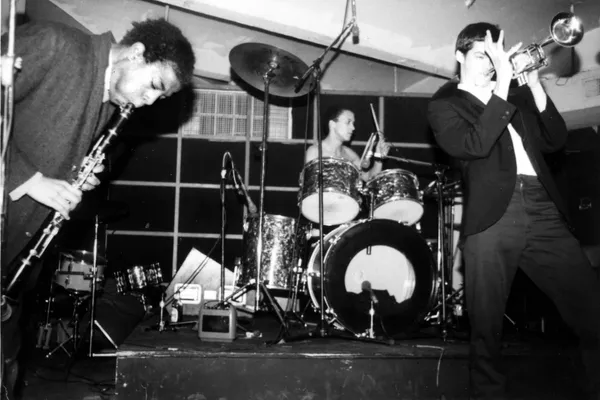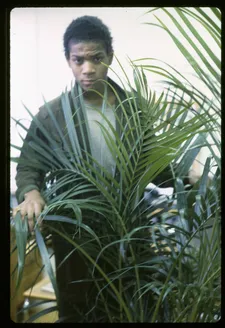Anthony McCarten’s The Collaboration (currently on Broadway at the Manhattan Theatre Club) with Jeremy Pope as Jean-Michel Basquiat and Paul Bettany as Andy Warhol, directed by Kwame Kwei-Armah takes liberties with time while Sara Driver’s inspiring Boom For Real: The Late Teenage Years Of Jean-Michel Basquiat (2018) captures the artist and the scene around him through on-camera interviews with Jim Jarmusch, Carlo McCormick, Fred Brathwaite (aka Fab 5 Freddy), Sur Rodney (Sur), Glenn O’Brien, Kenny Scharf, Lee Quiñones, Patricia Field, Jamie Nares, Lucy Sante, Al Diaz, Michael Holman, Jennifer Jazz, Coleen Fitzgibbon, Mary-Ann Monforton, Bud Kliment, Felice Rosser, and Alexis Adler, who says “If we don't tell the history, then others will, who weren't there and don't know the truth.”
 |
| Sara Driver with Alexis Adler, Ed Bahlman and Anne-Katrin Titze on Jean-Michel Basquiat: “He was so charismatic and charming.” |
In the first instalment with Sara Driver and scientist Alexis Adler (who took many of the photos of Jean-Michel Basquiat, his works and writings seen in the documentary) we start out discussing how the original idea for Boom For Real: The Late Teenage Years of Jean-Michel Basquiat came over a tea at the apartment Alexis shared with Jean-Michel. Later we are joined by 99 Records founder and producer (of ESG, Glenn Branca, Bush Tetras, Liquid Liquid) Ed Bahlman, who was one of the forces in the thriving creative world of New York City in the Seventies and Eighties and remains so till this day due to the influence the music has had on other recording acts over the past four-plus decades.
From New York, Sara Driver and Alexis Adler joined Ed Bahlman and me on Zoom for the start of an in-depth conversation on Jean-Michel Basquiat.
Anne-Katrin Titze: Happy New Year, Sara!
Sara Driver: Happy New Year to you too!
AKT: Nice to meet you Alexis!
Alexis Adler: Nice to meet you! Happy New Year!
AKT: Sara, you told me that the film, Boom For Real, would not have happened without Alexis and her collection?
SD: It instigated the whole thing! Right after I went over to her house for tea, after Hurricane Sandy had hit, it was like two weeks later, and Alexis said “You can’t believe, I went to my bank vault and I found all this early work of Jean-Michel’s when he lived with me.” And I looked at it and thought, this would make an amazing poem about our city and about Jean-Michel. And that was the beginning of it, right Alexis? It was a four-year journey.
AA: Yes!
AKT: And was it because of Sandy that you did look in the vault?
AA: Well, I had some of the work that Jean left me framed up on my wall and I had a mural that was my wall and the bathroom door. But there was other work that I had scooped up in a safe deposit box and didn’t see for 25 years. After Hurricane Sandy I started thinking, well, we had flooding here, the water got to about half a block away and all the basements on this block were flooded and the bank was just another block further, but the vault was in the basement and I started worrying about it.
Since I lived with Jean I had a whole career in science and had two kids, raised them up being a single mom - it was just busy. So I had not forgotten about it - I paid the fee every year - but I had not gone there. Everything had sort of melted together, I couldn’t remember exactly what I had. And it was just amazing. And then Sara said this is amazing and other people came by and started to say, oh, you got to do something with this!
AKT: Were some of those pieces the clothing?
AA: All of it, clothing, writing, drawings, collages, colour Xerox.
SD: We all knew about Alexis and Jean-Michel’s relationship and we had all seen the mural on the bedroom wall and a few other things that you had framed. But then when you showed me everything, like his writings, his poetry. She has fragments of a play that he wrote!
AKT: Is that the one with the priest we see in the film?
AA: Yes. And Andy. Though we don’t know exactly if he was referring to Andy Warhol. I think some of this work will be included into a show about Andy Warhol and Jean-Michel.
AKT: Sara you show the script pages long enough so we can actually read some of it. I hate it when documentaries show you something quickly, but you can’t really see anything. He misspelled the word priest, the third or fourth time it is used on one of the pages, which is so interesting. It matches the crossing out of words in his paintings, and makes dyslexia into a new art form.
Ed Bahlman joins our conversation: Hi Sara, hi Alexis! Of course I remember that time very well. I have my own fond memories of Jean-Michel. He used to come in to hear some music. So when Felice [Rosser] mentions all the industrial music that he liked, of course he came in to listen at 99. He used to get the music newspapers, NME, Melody Maker and Sounds and look through them and put them back. Sometimes he would come with a $20 bill and say “Here, that’s for you.” He would only come in when no one else was around. But he was great, I really loved him.
SD: He was so charismatic and charming. You could almost feel him walking on the street a block away. My problem with a lot of things that are being made right now, including the AI Andy Warhol - there’s no fun in any of this. And we had a lot of fun, right Alexis?
AA: We certainly did.
SD: Even the Nan [Goldin] movie [Laura Poitras’s recently Oscar-nominated documentary All The Beauty And The Bloodshed], it’s like everything is gloom and doom. I was talking to Lee Quiñones and he said that he started watching the Warhol series. And Warhol is standing in front of a mirror - and Lee’s like “yeah, now we’re going to go for it. We’re going to the clubs; we’re going to have fun!” And there’s no fun. That was a great period of creativity, of performance art. I mean after AIDS was around, then everything got a little grimmer. We lost a lot of our humour, we lost a lot of people, but there was an amazing amount of creativity during that period.
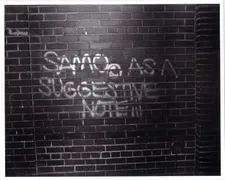 |
| Al Diaz and Jean-Michel Basquiat’s SAMO© AS A SUGGESTIVE NOTE III Photo: Jane Burell Yadav, courtesy of Magnolia Pictures |
AKT: The sense of humour in Basquiat’s work is so important. I liked how you started the film. The World Trade Center, cityscapes, and we hear the famous Gerald Ford speech.
SD: People don’t realise how grim it was. We were living in a war zone essentially. But for some reason we all felt very driven that our voices would get heard and we’d find our way somehow.
AKT: So how did you proceed from first seeing all these great objects? Did you then start reaching out to Jamie [Nares] and to everybody else?
SD: We did the first interviews with Alexis and that sort of led me. Also Carlo McCormack was very helpful too. I kind of let the footage and the interviews tell me how to make the film.
AKT: Being in a double interview, how did that feel for you?
AA: With Felice?
AKT: Yes.
AA: That’s good, because you know it was a long time ago and many things happened since then. Her memory is better than mine. So we work well together.
SD: Old friends!
AKT: I have to ask about some of the objects. What happened to the Grape Jelly refrigerator?
AA: It’s gone.
SD: How did you feel when you came home and you had Grape Jelly on your refrigerator, Alexis?
AA: It was really beautiful and I said oh I really liked it. And then a few days later he painted over it.
SD: You photographed it!
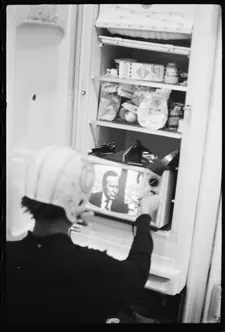 |
| Sara Driver on one of Alexis Adler’s candid images of Jean-Michel Basquiat: “You photographed him putting the TV into the refrigerator with the helmet on!” Photo: Alexis Adler |
AA: I knew something really special went on in my apartment, our apartment. I mean, we moved in together, we had no furniture. The middle room was just Jean’s art gallery. I knew he was an amazing artist and I said I got to get a camera and document this.
AKT: You knew right from the start?
AA: I knew it when I saw his and Al’s [Diaz] graffiti [SAMO©] in the neighborhood. I thought, wow, these people or this person is profound. And I was so excited to meet him when Felice introduced me to him. He would say at the time “I’m going to be a famous artist.” We were like “yeah, Jean,” but we knew. I’m not an artist, I’m a scientist, but there was something so special.
SD: You’re also a photographer, Alexis! Your photographs also drove the film. You photographed him putting the TV into the refrigerator with the helmet on! When Alexis was showing me these images, which may have been at the same tea, I thought “oh my god, I can make Jean-Michel alive again!” Animating this series of images that she had made.
AKT: I think it is Glenn O’Brien who calls the works “futuristic and homemade.” These two adjectives work perfectly. I also liked the little excursion into the history of shop windows.
SD: Isn’t that fascinating? It’s something that we never even really thought about or forgot about. That artists were doing that and that there was a tradition.
AKT: Dali and Rauschenberg at Bonwit Teller! And then Patricia Field’s shop being the first exhibit for Basquiat! I had no idea. How many of the “MANMADE” clothes are still out there, floating around? Not many I suppose?
AA: Not many. Surprisingly not many. I’d have thought that more would appear but they just haven’t appeared.
AKT: it’s funny, Kenny Scharf saying something along the lines of “Who would ever wear those sweatshirts? Who would buy a thing like that?” At another point he mentions that he believed Jean-Michel thought the he, Kenny, and his gang, were too childish and too silly. That’s an interesting balance.
SD: I don’t think it’s in the film, but Kenny told me that they met Jean at the School of Visual Arts and he was pretending to be a student.
AKT: What can you tell me about the Lee Quiñones film you are planning?
 |
| Sara Driver gives two thumbs up to producer Ed Bahlman and Alexis Adler holding up 99 Records 99-07 EP: “I love Liquid Liquid, yeah.” Photo: Anne-Katrin Titze |
SD: Well, Lee was a major instigator in so many things, I think people don’t realise. He does such a wonderful interview in Boom For Real; it was actually through Carlo McCormack, I didn’t really know Lee. And he graciously agreed to do the interview and we became friends. The Puerto Rican community was such a vibrant community. It was all around us, there were block parties and that’s all gone now. It was sort of like, here’s another ghost. Of what was our New York.
Lee has also made the transition from being a street writer, a street painter, to being acknowledged in the art world as a major figure. His story is just so fascinating. He told me one story about how the police had cornered him in a bathroom and they were pushing his head into a toilet to get him to turn in other artists, other writers on the subway. He was 15 years old. He asked the police “Why are you doing this to me? Why are you after me?” And they said “Well, you’re the most wanted person by the subway system, by the transit authority. And it’s because you’re an influencer and an instigator.”
Lee broke away from them and he ran like hell. They hadn’t found anything on them, no paint, no evidence. They just knew who he was. He ran away and he thought to himself “I’m an influencer and instigator” and he started doing these political murals on trains. And he was one of the first people to go above the train system to start painting on a handball court and did a huge mural at night in his school yard. That’s right around when SAMO started and they started doing stuff. And then Keith Haring started doing stuff in the subway stations. It’s a multi-faceted story.
EB: It’s similar to the way the music scene crossed over into that world too. Liquid Liquid’s first EP Al Diaz played metalphones on the record, Richard Edson played trumpet.
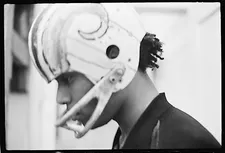 |
| Jean-Michel Basquiat in Ram football helmet Photo: Alexis Adler |
SD: I love Liquid Liquid, yeah.
EB: There was such a great crossover, just what’s explained in your film. [At this point Alexis holds up her Liquid Liquid record, then Ed holds up the same].
SD: Where’s my Liquid Liquid record?
EB: That’s a good one! That’s explained so well in the film also. There were no boundaries.
SD: There were no boundaries, everything was crossing into everything. Lee was telling me about records that he used to lift for the dance parties in the projects where he grew up. And a lot of those were the records that were the foundation of hip-hop.
EB: Exactly! Well, with Rick Rubin I did an event at the Diplomat Hotel with Liquid Liquid, Treacherous Three, and Heart Attack. That was in ’82 and it was the first hardcore band to perform with a hip-hop act and Liquid Liquid headlined.
SD: Do you have footage?
EB: No. It was the first Def Jam event when Rick was still at NYU. I helped him get together his first recordings, too. I told him whom to go to and where to get stuff printed and everything. That is so well explained in your film, it’s so much more than the late teenage years. Where did you get that subheading?
SD: Well, I limited the scope of the film. Jean-Michel’s life was a spiderweb. So I did it from ’78 to ’81 till he became famous.
EB: Jim [Jarmusch] explains it so well with the rose gift to you how he would just show up.
SD: It was actually a Bird of Paradise, which is kind of an obscene looking flower.
EB: Yes it is! So Jim cleaned it up?
 |
| Boom For Real: The Late Teenage Years Of Jean-Michel Basquiat poster |
AKT: For the film?
SD: He did! It was a memory thing.
AKT: Thank you all so much!
AA: Good talking to you!
SD: Nice to see you all!
AA: And 99 Records, that was like a home!
EB: I’m glad it could be, yes.
AA: I still have my record collection. I have my turntable over here.
EB: You’re really good with props!
AA: That’s Lee’s work [we see more artworks and the turntable as the tour continues].
EB: Alexis and Sara, say hi to Lee from me also!
SD: I will!
EB: It’s so great to see everybody and Diego Cortez saying “The age of the white male is over!”
SD: I know, dear Diego!
EB: Remember his outlaw parties?
SD: Yeah.
EB: We’re not supposed to say where they are!
Coming up - Alexis Adler on everything happening at the same time, a strong sense of community, a Jean-Michel Basquiat panel at The New School with Al Diaz, Michael Holman and Annina Nosei, Kevin Young’s book To Repel Ghosts, the Bishop Gallery connection to her recent HBCU tour and Sara Driver on prophet artists, screening Boom For Real: The Late Teenage Years of Jean-Michel Basquiat at Miami Basel, Beck Underwood’s fantastic Super 8 clothesline animation, and teaching kids at NYU to “make your mistakes.”
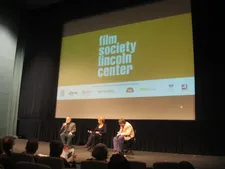 |
| Paul Bowles scholar Francis Poole with You Are Not I director Sara Driver and Richard Peña at the 49th New York Film Festival Photo: Anne-Katrin Titze |
On Saturday, February 4, following the 7:30pm screening of Boom For Real: The Late Teenage Years of Jean-Michel Basquiat at the Roxy Cinema there will be a discussion with Sara Driver, Alexis Adler, and Al Diaz. Also on the 4th, following the 5:45pm screening of Sleepwalk and on Wednesday, February 1, following the 5:45pm screening of You Are Not I, Sara Driver will participate in discussions. And on Friday, February 3, after the 7:15pm screening of Stranger Than Paradise and Stranger Than Rotterdam with Sara Driver, she will join Lewie Kloster and Noah Kloster for a conversation.
The Collaboration at the Manhattan Theatre Club Samuel J. Friedman Theatre has been extended to February 11, 2023.








